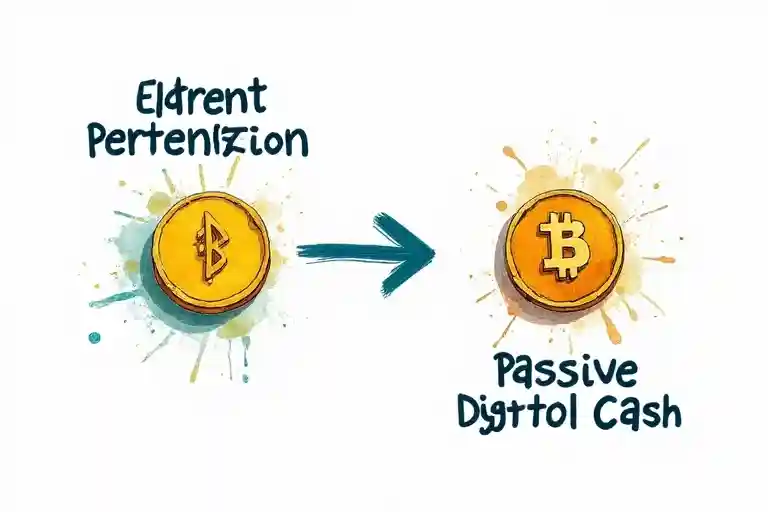Last updated: June 2025
Alright, let’s talk about something that’s buzzing louder than your TikTok ‘For You’ page: passive income with crypto. Sounds like something straight outta a sci-fi movie, or maybe your coolest cousin’s social media feed, right? You hear about people making bank with Bitcoin, Ethereum, and a whole bunch of other coins with wild names. But what’s the real deal, especially for us teens? Can you actually earn cash while you’re, like, sleeping or acing that math test? (Okay, maybe focus on the test first!). This guide is gonna break down how you can explore making passive income with crypto, what’s legit, what’s kinda sus, and how to do it safely. We’re talking real methods, no crazy get-rich-quick promises, just practical steps for American teenagers looking to dip their toes into the crypto world. So, grab your notes app, and let’s dive in! I was pretty amazed myself when I first started looking into this stuff; it’s a whole new world out there.
What Exactly IS Passive Income with Crypto Anyway?
Before we jump into the “how,” let’s get the “what” straight. You’ve probably heard “passive income” thrown around a lot. It’s that dream scenario where money flows into your account without you actively working for it 24/7. Think about it: your fave YouTuber probably earns ad revenue even when they’re not filming. That’s a type of passive income! When we add “crypto” to the mix, we’re talking about using cryptocurrencies – digital or virtual tokens that use cryptography for security – to generate ongoing earnings. This isn’t about day trading, which is super active and risky (and probably not the best starting point). We’re looking for ways your crypto can, metaphorically, do the work *for* you. Understanding how you can earn money from cryptocurrency as a teen is the first step.
Active vs. Passive: What’s the Diff?
So, what’s the big difference between active and passive income? Active income is what you get from a job where you trade your time and effort directly for money – like lifeguarding over the summer, babysitting, or working at the mall. If you don’t show up, you don’t get paid. Simple. Passive income, on the other hand, requires some upfront work or investment (sometimes time, sometimes a bit of cash, sometimes both!), but then it ideally starts generating money with minimal ongoing effort. Think about writing an e-book: you write it once, and it can sell copies for years. With passive income with crypto, the initial effort might be researching, setting up an account, or learning about a specific coin. Then, the crypto itself starts to (hopefully!) generate more crypto or cash. It’s not *totally* hands-off – you still need to monitor things – but it’s definitely different from clocking in for a shift.
Why Crypto for Passive Income? (The Hype vs. Reality)
Why all the hype round crypto for passive earnings mainly? Well, crypto continues to be a fairly new and exceptional dynamic area. This method there are progressive (and on occasion wild) ways to earn that don’t exist in traditional finance. The potential for better returns than your common savings account is a massive draw, but – and this is a HUGE but – it additionally comes with better dangers. You’ll see stories on line of humans making fortunes, however for every fulfillment, there are people who lose cash. The fact, specifically for teens, is that beginning small and that specialize in information the tech and the dangers is way greater crucial than chasing huge earnings in a single day. It’s much less about getting wealthy quick and extra approximately gaining knowledge of and probably incomes a bit on the side. Remember the “stonks” meme? Crypto may be even extra of a rollercoaster! So, buckle up and be clever.
7 ways to generate passive income with crypto
Okay, let’s get to the good stuff: the actual methods! There are quite a few avenues for trying to generate passive income with crypto. Not all of them will be suitable for everyone, especially teens, so we’ll highlight what to look out for. Remember, parental permission and guidance are your best friends here. Some of these methods might sound like they’re straight out of a video game, and honestly, some of them are almost as engaging!
1. Crypto Staking: Your Coins Working for You
Imagine you have got a few spare cash. Instead of it simply sitting there, you placed it in a unique savings account that pays you interest. Crypto staking is kinda like that, but with virtual coins! When you “stake” your crypto, you’re basically locking up your cash to assist guide the operations and protection of a blockchain community (the era behind most cryptocurrencies). In go back for supporting out, the community rewards you with extra cash. It’s one of the maximum popular ways to earn passively. Many essential cryptocurrencies like Ethereum (ETH), Cardano (ADA), and Solana (SOL) use a “Proof-of-Stake” gadget. Think of it like your coins are balloting and assisting to validate transactions, and that they get paid for his or her civic obligation! Platforms like Coinbase or Kraken regularly offer staking services, however ALWAYS check their phrases and age necessities – you’ll in all likelihood need a parent to assist set up an account in case you’re below 18.
2. Yield Farming: The High-Reward (and Higher Risk) Game
Alright, if staking is like a savings account, yield farming is like being a super-savvy investor looking for the absolute best returns, sometimes hopping between different opportunities. It involves lending or staking your crypto in decentralized finance (DeFi) protocols to earn rewards, often in the form of more crypto. The “yield” is the return you get. Yield farming can offer potentially high returns, sometimes *very* high. But here’s the catch, and it’s a big one: it’s also MUCH riskier and more complex than simple staking. It’s like that TikTok challenge that looks easy but… plot twist! It’s super hard. High rewards, but also high chance of an L if you’re not careful. You need to understand concepts like “impermanent loss” (yeah, it’s a thing), and DeFi platforms can be targets for hackers. For teens, this is an area to approach with extreme caution, if at all, and *only* with significant research and adult supervision. Most beginners should probably steer clear until they have a LOT more experience.
3. Crypto Lending: Be the Bank!
Ever thought about being the bank? With crypto lending, you kinda can be! You can lend out your crypto to borrowers through various platforms and earn interest on it. It’s simpler than yield farming and generally considered less risky, though not risk-free. Borrowers might be individuals or institutions who need crypto for various reasons (like trading or market making). Platforms act as intermediaries, connecting lenders with borrowers. The interest rates can be more attractive than traditional savings accounts. However, the main risk is “counterparty risk” – what if the platform gets hacked, or the borrower doesn’t repay? Always use reputable, well-established platforms and understand their insurance policies (if any). Again, age restrictions will apply, so parental involvement is a must.
4. Crypto Airdrops & Faucets: Free Crypto? (Yes, really!)
This is where it gets interesting for those starting with zero cash! Crypto airdrops are basically free tokens distributed by new (or existing) crypto projects to build a community and raise awareness. Sometimes, all you need to do is hold a certain coin or perform small tasks like joining a Telegram group or retweeting something. You can find lists of upcoming airdrops on sites like Crypto Airdrops List May 2025 » Free Token Opportunities. Crypto faucets are websites or apps that give out tiny amounts of cryptocurrency for free, usually for completing simple tasks like watching ads, solving captchas, or playing mini-games. You won’t get rich from faucets – we’re talking cents, or even fractions of cents, at a time. But, hey, it’s a way to get your very first crypto without spending any money! It’s like those free samples at the mall, but for digital money. A great way to earn cryptocurrency free without investment.
5. Content Creation & NFTs (Non-Fungible Tokens)
Got a creative streak? This could be for you! If you’re an artist, musician, writer, or even a meme lord, you can create and sell NFTs. NFTs are unique digital items (like art, music, collectibles) whose ownership is recorded on a blockchain. If your NFT becomes popular, you could earn royalties every time it’s resold – that’s passive income! Platforms like OpenSea or Rarible are popular NFT marketplaces. Alternatively, if you’re good at explaining things or have a passion for crypto, you could start a blog, YouTube channel, or TikTok account about crypto. Once you build an audience, you could earn through ads, sponsorships, or affiliate marketing (promoting products/services and earning a commission). This takes consistent effort to build up, but the passive income potential can be significant down the line. Just remember to be authentic and provide real value.
6. Cloud Mining: Digging for Digital Gold (Simplified)
You might have heard about crypto mining – using powerful computers to solve complex math problems to validate transactions and create new coins. Traditional mining is expensive, requires technical know-how, and uses a LOT of electricity (not very dorm-room friendly!). Cloud mining is an alternative where you rent computing power from a company that owns and operates the mining hardware. You pay a fee, and in return, you get a share of the mining rewards. It *sounds* easier, right? But be SUPER careful here. The cloud mining space has a lot of scams. Legitimate cloud mining services exist, but returns are often low after fees, and contracts can be confusing. If you explore this, stick to very well-known providers and understand that profits are not guaranteed. For most teens, the risk and complexity might outweigh the potential rewards compared to other methods. This is another area where research is your superpower.
7. Liquidity Pools: Diving Deeper
This one’s a bit more advanced, similar to yield farming in some ways. Decentralized exchanges (DEXs) need liquidity – basically, a supply of different cryptos so people can trade them easily. You can provide this liquidity by depositing a pair of crypto assets (like ETH and a stablecoin like USDC) into a liquidity pool. In return, you earn a share of the trading fees generated by that pool. This can be a good way to earn passive income, but it also comes with risks like “impermanent loss,” which happens when the price ratio of the two assets you deposited changes significantly. It’s like, you put in half chocolate, half vanilla ice cream, and if everyone suddenly wants chocolate, your vanilla share might be worth less for a bit. It’s a cool concept, but definitely do your homework and start small if you decide to try it, ideally with adult guidance.

Best passive income with crypto
So, with all these options, what’s the *best* way to earn passive income with crypto? Well, spoiler alert: there’s no single “best” way for everyone. It’s like asking what the best TikTok dance is – it depends on your style, your skills, and what you’re comfortable with! What works for your favorite crypto influencer might not be right for you as a teen just starting out. The key is to find methods that align with your knowledge level, the amount of time (and potentially money, though we’re focusing on low/no cost) you can commit, and your risk tolerance (which should be pretty low when you’re young!). Thinking about how to approach making money with cryptocurrency for beginners is crucial.
Comparing Top Methods
Let’s break down some of these methods in a table to give you a clearer picture. Remember, “Potential Returns” and “Risk Level” are general estimates and can vary wildly!
| Method | Effort to Start | Potential Returns | Risk Level | Teen-Friendly? (Age/Consent Needed) |
|---|---|---|---|---|
| Staking | Low-Medium | Low-Medium | Medium | Yes, with parental help for account setup on most platforms. |
| Yield Farming | Medium-High | Medium-High | High | Caution advised; very complex and risky for beginners/teens. |
| Crypto Lending | Low-Medium | Low | Low-Medium | Yes, on select platforms with parental consent/setup. |
| Airdrops & Faucets | Low | Very Low | Low | Yes! Great for starting with no money. Be mindful of time spent. |
| Cloud Mining | Low | Low-Medium | Medium-High | High scam risk. Research platforms VERY carefully; parental guidance essential. |
| Content Creation/NFTs | Medium-High (requires skill/effort) | Variable (can be high) | Medium (market risk for NFTs) | Yes! Great way to use creativity. Platform age limits apply. |
| Liquidity Pools | Medium | Low-Medium | Medium-High | More advanced; requires good understanding and caution. |
What’s “Best” for *You* as a Teen? (Considering age, capital, risk)
For most teens, especially if you’re just starting and have little to no money to invest, things like crypto faucets and airdrops are fantastic entry points. They let you earn crypto coin free fast (well, “fast” in terms of getting *some* crypto, not getting rich fast). You learn how wallets work and get a feel for the crypto space without risking your own cash. As you learn more (and ALWAYS with parental permission and oversight if finances are involved), exploring staking or lending on reputable platforms could be a next step. Content creation around crypto or making NFTs is also a solid option if you’re creative – you’re building skills alongside potentially earning. The “best” path is the one that educates you, keeps you safe, and fits your current situation. Maybe avoid the “Go big or go home!” mindset for now; think “Learn big and grow steady!” instead.
Staking crypto earn passive income daily
Let’s zoom in on staking because it’s one of the most talked-about methods to staking crypto earn passive income daily (or at least regularly). The idea of your crypto earning more crypto just by holding it is pretty appealing, almost like your digital pets having digital babies! But how does it work without getting too technical? And can you really earn *daily*? Some platforms do pay out rewards daily, while others might be weekly or monthly. It’s all about how the specific blockchain network and the staking platform operate.
How Staking *Actually* Works (ELI5 style)
Okay, ELI5 (Explain Like I’m 5) for staking: Imagine a big group of friends (the blockchain network) needs to agree on what game to play next (validate transactions). Some friends offer to put their favorite toys (their crypto coins) in a special box (they “stake” them) to show they’re serious about helping decide fairly. Because they’re helping keep things running smoothly and honestly, they get a small reward – maybe an extra cool sticker or a new small toy (more crypto). The more toys you put in the box (the more coins you stake), and the longer you leave them there, the more rewards you might get. Your staked coins are still yours, but they’re locked up for a period, helping the network. That’s the basic idea! You’re supporting the network, and the network says “thanks!” with rewards. Cool, huh?
Popular Platforms for Staking (mentioning age limits/parental consent)
Several major exchanges like Coinbase, Binance, and Kraken offer staking services. They often make it pretty easy – you just choose the coin you want to stake from their list, and they handle a lot of the technical stuff. There are also dedicated staking-as-a-service platforms and even ways to stake directly from your own crypto wallet for some coins (which is more advanced). **CRITICAL NOTE for teens:** Most of these platforms require users to be 18+. This means if you’re younger, you’ll absolutely need a parent or guardian to open a custodial account or manage the account for you. NEVER lie about your age to sign up for these platforms – it can lead to your account being frozen and losing access to your funds. Safety and honesty first, always!
Risks Involved in Staking Your Crypto
While staking is often seen as less risky than, say, active trading or yield farming, it’s not risk-free. What are the downsides?
1. **Market Volatility:** The price of the crypto you’re staking can go down! If your coin drops 20% in value, even if you earn 5% in staking rewards, you’re still down overall. Crypto prices are famously like a rollercoaster – thrilling but unpredictable.
2. **Lock-up Periods:** Some staking arrangements require you to lock your coins for a specific period (e.g., 30, 60, 90 days). During this time, you can’t sell them, even if the price is crashing.
3. **Slashing:** If the validator node you’re staking with (often managed by the exchange if you’re using one) misbehaves or goes offline, a portion of the staked coins (including yours) could be “slashed” or penalized by the network.
4. **Platform Risk:** The exchange or platform you’re using could get hacked, go bankrupt, or face regulatory issues.
It’s important to weigh these risks against the potential rewards. Never stake more than you can afford to lose.
Crypto passive income reddit
Ah, Reddit. The land of endless scrolling, cat memes, and… surprisingly detailed discussions about crypto passive income reddit communities can be a goldmine of information, personal experiences, and emerging trends. Subreddits like r/CryptoCurrency, r/CryptoPassiveIncome, or specific coin subreddits are buzzing with chatter. But, like navigating a massive online party, you need to know who to listen to and what to take with a grain of salt (or a whole shaker sometimes!). It’s a place where you can find insights, but also a lot of hype and, occasionally, bad advice.
What Are Redditors Saying? (Pros and Cons from the community)
Dive into Reddit threads about passive income with crypto, and you’ll see a mix of everything.
**Pros often highlighted:**
* **Discovery of new projects:** Redditors are often among the first to jump on new staking opportunities or airdrops.
* **Detailed guides and AMAs:** Some experienced users share incredibly helpful step-by-step guides or participate in “Ask Me Anything” sessions.
* **Real-time problem solving:** If you hit a snag, chances are someone on Reddit has faced it too and can offer a solution.
**Cons and Cautions:**
* **Shilling and Scams:** SO. MUCH. SHILLING. People will aggressively promote coins they’re invested in (often low-quality ones, AKA “shitcoins”) hoping to pump the price. Scammers also lurk, trying to get you to click dodgy links or reveal your private keys. (Rule #1: NEVER share your private keys!)
* **Echo Chambers:** Subreddits can become echo chambers where everyone just agrees with each other, and critical views are downvoted. This can give a false sense of security about a particular investment.
* **Overwhelming Hype:** It’s easy to get caught up in FOMO (Fear Of Missing Out) when you see posts about massive gains. Remember, people rarely brag about their losses.
When I was first exploring, I saw a post about a “guaranteed 1000% APY” coin. My brain screamed “Too good to be true!” and thankfully, further digging (and more sensible Reddit comments) confirmed it was a super risky, likely scammy project. That reminded me: if it sounds like a cheat code for unlimited money, it’s probably not real.
Finding Reliable Info vs. Getting Rekt (Navigating online forums)
So how do you use Reddit for good and avoid getting “rekt” (crypto slang for losing a lot of money)?
1. **Cross-reference everything:** If you see a promising tip on Reddit, Google it. Check official project websites, look for news articles from reputable crypto media (like CoinDesk or Cointelegraph – though still read critically!), and see what other communities are saying.
2. **Look at user history:** Click on a user’s profile. Are they a new account just spamming one coin? Or do they have a history of thoughtful contributions across different topics?
3. **Be wary of DMs:** Scammers LOVE direct messages. Be highly suspicious of anyone DMing you offering “help” or investment advice, especially if it involves clicking links or sharing info.
4. **Focus on educational content:** Look for posts that explain *how* things work, not just *what* to buy. The “why” is often more valuable.
5. **Remember, it’s not financial advice:** Most Redditors are just sharing opinions. Don’t treat it as professional financial advice. This is especially true for exploring crypto earnings and how to earn crypto free – the free methods are lower risk but still require due diligence. Treat Reddit like a giant, chaotic library – amazing resources, but you need to be a discerning reader.

Passive income crypto mining
Let’s talk about passive income crypto mining. This is the OG way of earning crypto for some coins like Bitcoin. Miners use powerful computers to solve complex mathematical problems, which validates transactions and secures the network. For doing this “work,” they get rewarded with newly minted coins and transaction fees. Sounds like a cool way to earn, right? Like you’re actually *creating* digital money! But is it still a viable option for passive income, especially for teens?
Is Traditional Mining Still a Thing for Teens? (Probably not solo)
For most teens, setting up a traditional Bitcoin or Ethereum (though Ethereum is moving away from mining) mining rig at home is probably not realistic. Here’s why:
* **Cost:** Application-Specific Integrated Circuit (ASIC) miners for Bitcoin or high-end GPUs (graphics cards) for other coins can cost thousands of dollars. Ouch.
* **Electricity:** These machines consume a TON of electricity. Your parents might not be thrilled with the power bill sky-rocketing! Seriously, it can be like running multiple air conditioners 24/7.
* **Heat and Noise:** Mining rigs generate a lot of heat and noise. Not ideal for your bedroom.
* **Technical Know-How:** Setting up and maintaining mining hardware and software requires a good amount of technical skill.
* **Competition:** You’d be competing against massive mining farms with warehouses full of specialized equipment. It’s like trying to win a Formula 1 race with a go-kart.
So, while the idea is cool, solo traditional mining is generally out of reach and not very “passive” due to the maintenance involved for individuals, especially younger enthusiasts.
Cloud Mining: A More Accessible Option? (Pros and Cons)
This brings us back to cloud mining. As we touched on earlier, cloud mining allows you to rent mining power from a company that handles the hardware, electricity, and maintenance. You pay a fee for a contract, and you get a share of the crypto mined.
**Pros:**
* **No hardware to buy or manage:** This is the big appeal. No noise, no heat, no crazy electric bills at your house.
* **Lower entry cost (sometimes):** You can often start with a smaller investment than buying your own rig.
* **Potentially passive:** Once set up, it *should* be hands-off.
**Cons (and these are BIG ones):**
* **SCAMS, SCAMS, SCAMS:** The cloud mining space is notorious for fraudulent operations. Many “companies” just take your money and disappear. It’s incredibly hard to verify if they even have any real mining equipment. This is where you can get that “Oops, I clicked the sus link” feeling, but with your actual money.
* **Low Profitability:** Even legitimate cloud mining services often have high fees or unfavorable contract terms that eat into any potential profits. The returns might be less than if you just bought and held the crypto.
* **Lack of Control & Transparency:** You don’t own the hardware and have little visibility into the actual mining operations.
If you’re even *thinking* about cloud mining, you need to do EXTREME due diligence. Research the company extensively, look for independent reviews (not just ones on their own site!), understand the contract terms inside out, and be very skeptical. For most teens, the risk of scams likely makes cloud mining a no-go zone. There are safer ways to get involved with passive income with crypto.
Staying Safe: The Golden Rules for Teens in Crypto
Okay, this is probably THE most important section. The crypto world is exciting, but it can also be like the Wild West sometimes. There are scams, phishing attempts, and lots of ways to lose your digital assets if you’re not careful. As a teen, you’re often a target because scammers might think you’re less experienced. So, let’s lay down some golden rules for staying safe while exploring passive income with crypto. These are non-negotiable!
Rule #1: Parental Permission is KEY!
I’ve said it before, and I’ll say it a million more times: if you are under 18, you NEED to involve your parents or a trusted guardian. Period. Many crypto platforms require users to be 18+ to sign up legally. Trying to bypass this by using false information can get your account shut down and your funds frozen. Beyond that, having an adult who knows what you’re doing provides an extra layer of safety. They can help you understand complex terms, spot potential scams, and make sensible decisions. Think of them as your crypto co-pilot. This isn’t about them cramping your style; it’s about them helping you navigate a tricky space safely. If you’re looking into Coinbase learning rewards for free crypto, for instance, discuss how to set up an account properly with them.
Rule #2: DYOR – Do Your Own Research (Don’t trust randos)
You’ll see “DYOR” plastered all over crypto communities. It stands for “Do Your Own Research,” and it’s vital. Don’t just jump into a coin or a platform because some influencer on TikTok hyped it up or a random person on Reddit promised massive returns. What does DYOR actually mean?
* Read the project’s whitepaper (the document explaining what the crypto does).
* Check out the team behind the project. Are they experienced and reputable?
* Look at the coin’s utility. Does it actually *do* anything useful?
* Understand the tokenomics (how the coins are created, distributed, etc.).
* Read reviews and opinions from multiple trusted sources, not just one.
It’s like when you’re trying to decide if that new viral game is worth downloading – you read reviews, watch gameplay, you don’t just click download ’cause one person said it was “lit.”
Rule #3: Secure Your Wallets & Keys (Like your life depends on it!)
Your crypto wallet holds your digital assets. Your private keys are the super-secret passwords that give you access to those assets. If someone gets your private keys, they can steal ALL your crypto. Poof, gone.
* **Use strong, unique passwords** for everything crypto-related.
* **Enable two-factor authentication (2FA)** wherever possible. This adds an extra layer of security beyond just your password.
* **NEVER, EVER, EVER share your private keys or seed phrase** (a list of words that can recover your wallet) with ANYONE. No legitimate support person will ever ask for them. If someone does, it’s a scam. 100%.
* **Be super careful about phishing scams.** These are fake emails, texts, or websites designed to look like legitimate platforms to trick you into giving up your login info or private keys. Always double-check website URLs.
Think of your private keys like the actual keys to a vault full of cash. You wouldn’t just hand them over, right? Same with crypto.
Rule #4: Understand the Tax Man (Yeah, even for crypto) – Simplified.
Ugh, taxes. I know, I know, it’s boring. But it’s also super important. In many countries, including the US, crypto is treated as property for tax purposes. This means if you earn crypto (from staking, airdrops, mining, etc.) or if you sell crypto for a profit, you might owe taxes on it. Even trading one crypto for another can be a taxable event. The rules can be complicated and are still evolving. While you might not be earning huge amounts as a teen, it’s crucial to be aware of this. Keep good records of your transactions. If you start earning any significant amount, your parents will definitely need to help figure out the tax implications. Ignoring taxes can lead to big problems down the road. It’s definitely not as fun as watching your crypto balance go up, but it’s part of being a responsible crypto user.
Getting Started: Your First Steps into Passive Crypto Earnings
Feeling a bit overwhelmed? Totally normal! The crypto world is vast. But getting started with earning passive income with crypto doesn’t have to be super complicated. The key is to start small, focus on learning, and prioritize safety. Here’s a simplified path to take your first baby steps, always with your parents in the loop!
Setting Up Your First Wallet (Safely!)
Before you can earn crypto, you need a place to store it: a crypto wallet. There are different types:
* **Software Wallets (Hot Wallets):** These are apps on your phone or computer (e.g., Exodus, Trust Wallet, MetaMask). They are convenient for everyday use but are connected to the internet, making them slightly more vulnerable.
* **Hardware Wallets (Cold Wallets):** These are physical devices (like a USB drive, e.g., Ledger, Trezor) that store your keys offline. They are much more secure but cost money.
* **Exchange Wallets:** When you sign up for an exchange like Coinbase, they provide a wallet. Convenient, but you don’t fully control the private keys (the exchange does).
For beginners, a reputable software wallet or an exchange wallet (with parental setup) is a common starting point. **The MOST important part:** When you set up a wallet, you’ll get a “seed phrase” or “recovery phrase” (usually 12 or 24 words). Write this down on paper, store it in MULTIPLE safe, secret places, and NEVER share it. This phrase can recover your wallet if you lose your device. If you lose the phrase and your device, your crypto could be gone forever. No pressure, but yeah, it’s that important!
Where to Get Your First Bits of Crypto (Legally and with permission)
So, how do you get your hands on some crypto to start experimenting with passive income methods?
1. **Crypto Faucets:** As mentioned, these sites give tiny amounts of crypto for free for completing tasks. It’s slow, but it’s *free* and a great way to learn. Check out guides like Top 6 Crypto Faucets for some options.
2. **Learn & Earn Programs:** Some platforms, like Coinbase, have “Learn & Earn” programs (check out Coinbase Learn and Earn crypto opportunities) where you can watch short videos about different cryptocurrencies and answer quizzes to earn small amounts of those coins. It’s educational AND you get free crypto!
3. **Airdrops:** Keep an eye on airdrop listing sites. You might qualify for some free tokens just by having a wallet or following social media accounts.
4. **Gifts:** Maybe a crypto-savvy relative might be willing to gift you a small amount to get started (with your parents’ permission, of course!).
5. **Earning it (Non-Passively First):** If you have a part-time job or do chores, you could (with parental help) convert a very small amount of your earnings into crypto via an exchange. Only use money you can absolutely afford to lose.
Focus on these low-risk methods to accumulate a small amount to experiment with staking or lending later on.
Learning More: Resources for Young Crypto Enthusiasts
The crypto space changes FAST. Continuous learning is key. Besides your own research:
* **Reputable Crypto News Sites:** CoinDesk, Cointelegraph, Decrypt.
* **Educational Websites:** Binance Academy, Decrypt Learn, CoinGecko Learn. Many offer beginner-friendly guides.
* **YouTube Channels:** Look for channels that focus on education rather than hype and price predictions. Some good ones explain concepts clearly. (Always be wary of “buy this now!” advice).
* **Books and Courses:** There are many beginner books on Bitcoin and blockchain. Some online learning platforms also offer introductory crypto courses.
* Your own exploration on Zana Website for topics like making money on crypto can also be a starting point.
The more you learn, the better equipped you’ll be to identify real opportunities for passive income with crypto and avoid the pitfalls. It’s a marathon, not a sprint! And who knows, maybe you’ll become the crypto expert in your friend group (the responsible, safe one, of course!).
Remember, exploring passive income with crypto as a teen can be an exciting learning experience. Prioritize safety, involve your parents, start small, and focus on understanding the technology. It’s less about getting rich quick and more about building knowledge for the future. Good luck, and stay curious!
Conclusion
Phew! We’ve covered a LOT about generating passive income with crypto, especially for you awesome teens. From staking your coins and lending them out, to hunting for airdrops and even dabbling in cloud mining (cautiously!), there are definitely ways to make your crypto work for you. The key takeaways? Start small, prioritize learning over earning (especially at first!), and NEVER skimp on security or parental guidance. Remember those TikToks where someone tries a complicated hack and it goes hilariously wrong? Yeah, don’t let that be your crypto journey – do your research! The crypto world is like a giant, evolving video game with real stakes; understanding the rules and playing smart is how you level up.
So, what’s your next move? Are you going to research some crypto faucets or talk to your parents about setting up a learning account on an exchange? Drop a comment below and let us know what method sounds most interesting to you! And hey, if you found this guide helpful, why not share it with your friends on TikTok or Instagram? Let’s spread the knowledge (safely!).
Stay Updated! The world of crypto is always changing, with new platforms emerging and regulations shifting. Keep checking back on Zana.website for the latest scoop, new methods, and safety tips to help you navigate your crypto journey. We’re always on the lookout for fresh, teen-friendly info!
Frequently Asked Questions
1. Can you make passive income from crypto?
Yes, you absolutely can make passive income from crypto! Methods like staking (locking up your coins to support a network and earn rewards), lending your crypto to others for interest, participating in yield farming, or even receiving airdrops are all ways to generate earnings without actively trading. It requires research and understanding the risks involved.
2. Can you make $100 a day with crypto?
Making $100 a day with crypto passively is possible, but it usually requires a significant upfront investment or finding a very high-yield (and often high-risk) opportunity. For teens starting small, this is an unrealistic immediate goal. Focus on learning and gradual growth rather than specific daily income targets, especially early on.
3. Can you make $1000 a month with crypto?
Similar to making $100 a day, earning $1000 a month passively from crypto typically needs a substantial amount of capital staked or lent in reliable projects, or higher involvement in riskier ventures like yield farming. It’s not a typical outcome for beginners or those with limited funds. Always be wary of promises of such high returns with low effort.
4. Can you make an income from crypto?
Yes, you can definitely make an income from crypto, both actively (like trading or working for a crypto company) and passively as we’ve discussed. Passive methods like staking or lending can provide a stream of income, but its reliability and amount depend heavily on your investment, chosen methods, and market conditions.
5. How to make money in crypto without money?
You can start making money in crypto without investing your own cash by using crypto faucets (websites giving free crypto for tasks), participating in airdrops (free tokens from new projects), engaging in learn-and-earn programs on exchanges, or creating crypto-related content if you have skills in writing, video, or art (NFTs).









